Part Twenty Five Why study social media, chiasm, the Declaration of Independence, and Constitution, and inspiration?
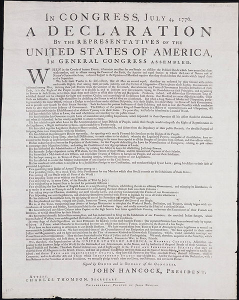 Dunlap Broadside of the Declaration of Independence, printed within two days after July 4th 1776. Note this version was before the Unanimous Declaration, as signed in August 1776, by the Delegates. 200 copies were Printed by John Dunlap in Philadelphia, Pennsylvania as ordered by John Hancock. Of the 13 states which sent delegates to the Convention, as of July 4th, 12 voted for Independence, none against, and New York’s delegate abstained, did not vote, as no directions had been received from the New York Assembly. So although the vote was without dissent as of July 4th, it was not unanimous yet. New York Assembly did approve and sent word to its delegate in Philadelphia, which approved the declaration and signed the engrossed copy as the Unanimous Declaration.
Dunlap Broadside of the Declaration of Independence, printed within two days after July 4th 1776. Note this version was before the Unanimous Declaration, as signed in August 1776, by the Delegates. 200 copies were Printed by John Dunlap in Philadelphia, Pennsylvania as ordered by John Hancock. Of the 13 states which sent delegates to the Convention, as of July 4th, 12 voted for Independence, none against, and New York’s delegate abstained, did not vote, as no directions had been received from the New York Assembly. So although the vote was without dissent as of July 4th, it was not unanimous yet. New York Assembly did approve and sent word to its delegate in Philadelphia, which approved the declaration and signed the engrossed copy as the Unanimous Declaration.
This is Part Twenty Four and Twenty Five of a series showing how inflation, postage, history, economics, religion, and education are combined into one great whole. Postage rates demonstrate how money has changed value.
Part Twenty Five Why study social media, chiasm, the Declaration of Independence, and Constitution, as they affect inspiration.
Inspired from on High: the Declaration of Independence and Constitution
To the Latter-Day Saint, patriotic celebrations in the United States of America should have a special meaning. For 2018, CBS news reported ‘’A Facebook algorithm categorized parts of the Declaration of Independence as hate speech and took down excerpts of it ahead of the Fourth of July.’’ ‘’Facebook sent a notice that one of those parts “goes against our standards on hate speech.” Facebook said in a statement to CBS News, “The post was removed by mistake and restored as soon as we looked into it. We process millions of reports each week, and sometimes we get things wrong.” What else does Facebook get wrong?
Chiasm is a specific form of poetry used in Scripture. It is also found in the first paragraph of the Declaration of Independence, as exampled by verse 6.
Key #3 – Declaration of Independence, verse 6
A Laws
…… B of Nature and
. . . .B’ of Nature’s
A’ God
Note the parallel structure in which the word “laws” is balanced by the law giver “God,” around the central thought of nature. Welch also observed that “chiasmus is not limited to short passages. It may also be used to give order, emphasis, and completeness to longer passages.” Notice the reference from third Nephi that follows key ABCDA’C’B’D’:
Key #4 – Book of Mormon 3 Nephi 11:37-38
A And again I say unto you, ye must repent, and
B become as a little child, and
C be baptized in my name,
D or ye can in nowise receive these things.
A’ And again I say unto you, ye must repent, and
C’ be baptized in my name, and
B’ become as a little child,
D’ or ye can in nowise inherit the Kingdom of God,
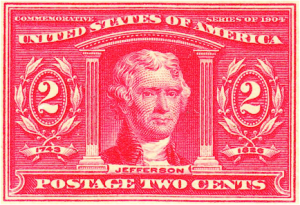 Jefferson 1743-1826 Postage Two Cents United States of America Commemorative Series of 1904, red.
Jefferson 1743-1826 Postage Two Cents United States of America Commemorative Series of 1904, red.
The chiasmus makes the poem harmonic and brilliant, Welch observed. The knowledge of chiasm is stimulating new thoughts about the nature of sacred literature, and reevaluating the skill and deliberation with which it was written. Chiastic passages that appeared repetitious before, have now become clear. Other places that once seemed disorganized, have now regained their intended orderliness. We have learned once again that, if we are to judge the literature of another culture, we must not judge it according to our personal taste. 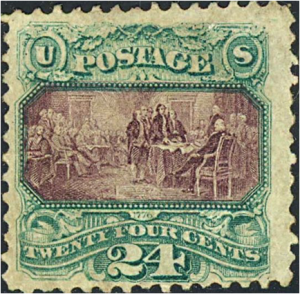 “The fact that chiasmus was a unique and prevalent form of Hebrew writing requires us to take it into account when we consider the literary accomplishments of ancient Israel.” 1869 U.S. Postage 24 Twenty Four Cents, 1776, Presentation of the Declaration of Independence to the Continental Congress, seated John Hancock, from painting by John Trumbull.
“The fact that chiasmus was a unique and prevalent form of Hebrew writing requires us to take it into account when we consider the literary accomplishments of ancient Israel.” 1869 U.S. Postage 24 Twenty Four Cents, 1776, Presentation of the Declaration of Independence to the Continental Congress, seated John Hancock, from painting by John Trumbull.
The Book of Mormon, along with the Declaration, contain chiasms of all sorts, long and short, poetical and phonetic, simple and elaborate (See Declaration Keys #21 et seq at the end). They are all artistic and meaningful. Very often, the prophets of the Book of Mormon use chiasm as a device to focus attention upon the essential idea of their message. The thought is focused by placing the central idea at the turning point of the chiasm. Significantly enough, Welch states that the central idea of the majority of chiastic passages in the Book of Mormon, he observed, dealt with the divinity of Jesus Christ and man’s direct relationship to him. 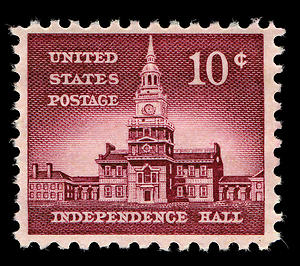 10 C United States Postage Independence Hall, issued July 4, 1956. Drawing by Charles R. Chickering. The hall was built as the Pennsylvania Capitol from 1732 to 1753.
10 C United States Postage Independence Hall, issued July 4, 1956. Drawing by Charles R. Chickering. The hall was built as the Pennsylvania Capitol from 1732 to 1753.
There is an example of this use of focus in a Declaration of Independence chiasm:
“the rights of the people. He has refused for a long time, after such dissolutions, to cause others to be elected; whereby the Legislative powers, incapable of Annihilation, have returned to the People at large for their exercise.” This key might be as follows:
Key #5 – Declaration of Independence, verses 50-53
A the RIGHTS
B of the PEOPLE. He
C has REFUSED for a long time,
D after such DISSOLUTIONS,
E to cause OTHERS to be ELECTED;
E’ where by the LEGISLATIVE powers,
D’ INCAPABLE of ANNIHILATION,
C’ have RETURNED
B’ to the PEOPLE at large, for
A’ their EXERCISE
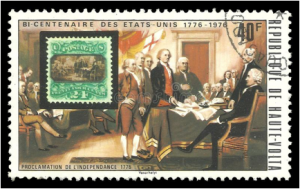 Republic of Haute-Volia, Bi Centenair des Etats – Unis 1776-1976, Proclamation de L’independence 1776. Painting by John Trumbull.
Republic of Haute-Volia, Bi Centenair des Etats – Unis 1776-1976, Proclamation de L’independence 1776. Painting by John Trumbull.
Is it not appropriate to balance rights by their exercise, as is done in lines A and A’? And do not both belong to the people, as in lines B and B’? And is it not true that that which is refused must be returned, as in lines C and C’? Cannot a dissolution be a form of annihilation as in D and D’? Is it not a beautiful contrast to be able to cause others to act, on the one hand, but to be incapable of such power on the other, as in E and E’? Is this chiasm not focused on the elected legislature? The principle idea for this verse is a key thought in the Declaration of Independence. The word order of these passages is undeniably chiastic.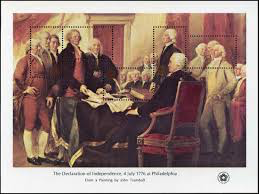 The order is just right to describe the turning around that occurs from the loss of rights to the return of these same rights to the people.vvAmerican Revolution Bicentennial 1776-1976
The order is just right to describe the turning around that occurs from the loss of rights to the return of these same rights to the people.vvAmerican Revolution Bicentennial 1776-1976
Chiastic passages from the Book of Mormon appear at Mosiah 3:18, 19; 5:10-12; 27:24-31 and Alma 36:1-30; 41:13-15. The modern discovery of chiasm is attributed to Robert Lowth (1710-1787) according to the Encyclopaedia Judaica (Macmillan, 1971). He was appointed Professor of Poetry at Oxford in England in 1741. A series of 34 Latin lectures describing literary qualities of biblical poetry were published in 1753. Only the 19th lecture concerns parallelism, but it was developed at length and published in 1787 and 1834. Lowth identified three kinds of parallelism, of which chiasm was only one variety. The chiasm was also called the introverted parallelism. As recently as 1925, the Jewish Encyclopedia (Funk and Wagnalls Company, vol. 9, p. 521) devoted but one paragraph to the chiastic arrangement of its parallelism example. Discussions in these encyclopedia are focused on only two, four or six verse arrangements. The King James version of the Bible has obscured many of the chiasm formations from the original Hebrew. Prof. Welch wrote that, “either in an attempt to avoid redundant repetitions or to prevent awkward word orders, the King James translators did a good job of leveling almost every chiasm in the Bible. Their good style is anathema to ‘good Hebrew.’”
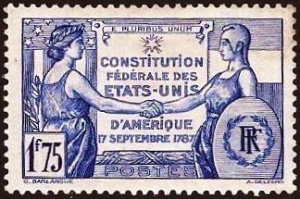 While relatively simple two and four verse parallelisms were being discussed in Latin by an Oxford professor, the young William and Mary graduate, Thomas Jefferson was drafting a most complex chiasm for use as the Declaration of Independence. Eleven years after the Declaration, Lowth’s lectures were translated into English, the same year the American Constitution was adopted. 1937 150th anniversary of the Constitution Federale Des Etats-Unis D’Amerique 17 Septembre 1787, 1f75. Postes RF.
While relatively simple two and four verse parallelisms were being discussed in Latin by an Oxford professor, the young William and Mary graduate, Thomas Jefferson was drafting a most complex chiasm for use as the Declaration of Independence. Eleven years after the Declaration, Lowth’s lectures were translated into English, the same year the American Constitution was adopted. 1937 150th anniversary of the Constitution Federale Des Etats-Unis D’Amerique 17 Septembre 1787, 1f75. Postes RF.
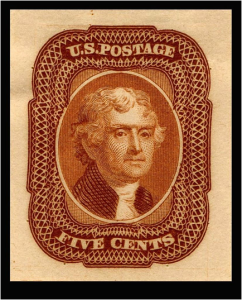 1856 U.S. Postage Five Cents Jefferson brown.
1856 U.S. Postage Five Cents Jefferson brown.
On July 8, 1776 outside the Pennsylvania State House, the Declaration was First read to the public. During the ensuing celebration, people cheered, bells rang out and soldiers paraded. After obtaining New York’s approval on July 15, Congress ordered it engrossed on the 19th in preparation for the signatures. At this time the title was changed from “A Declaration by the Representatives of the United States of America in General Congress Assembled” to “The Unanimous Declaration of the Thirteen United States of America.” The official signing occurred on August 2, 1776 when 50 men secretly took part. Later six more added their names. Not until January 18, 1777 in the wake of Washington’s victories at Trenton and Princeton, did Congress, which had sought to protect the signers from British retaliation for as long as possible, authorize printing of the Declaration with all their names listed. Five more years of struggle and bloody campaigning lay ahead. In 1783, Britain in the Treaty of Paris officially recognized the independence that had been proclaimed in 1776.

 Six Pence Continental currency. 10th April 1777, Philadelphia Printed by John Dunlap. This bill is included because it was printed on the same press as John Dunlap’s Broadside of the Declaration of Independence, printed about July 6, 1776, a copy of which was forwarded to General Washington in New York to be read to the troops.
Six Pence Continental currency. 10th April 1777, Philadelphia Printed by John Dunlap. This bill is included because it was printed on the same press as John Dunlap’s Broadside of the Declaration of Independence, printed about July 6, 1776, a copy of which was forwarded to General Washington in New York to be read to the troops.
Jefferson was well prepared for the assignment, even as the “ancient and modern prophets.” A native Virginian, Jefferson lived on a plantation, and had been a life long student of natural philosophy and the arts, a man who read easily in Greek, Latin, French and Italian. When he was able, he practiced three hours a day on the violin. At the age of 17, he attended college at William and Mary in Williamsburg, capital of the colony. He studied law with George Wythe and in 1769 at the age of 21 he came into his inheritance. He had one of the most notable private libraries in the colonies, of approximately 1200 volumes in 1776, which upon his death fifty years later, was donated to the United States for the beginning of the Library of Congress. In 1768, the year before he began work on the Monticello property, which can be observed on the back of the Jefferson nickel, Jefferson was elected to a seat in Virginia’s House of Burgesses. He was considered shy and always avoided open debate. However his quick pen and broad intellectual background soon made him an important advocate of the American resistance to Parliament.
By mid-April 1776, drafter Benjamin Franklin advised a friend: “Nothing Seems wanting but the ‘general consent’. The novelty of the thing [independence] deters some, the doubts of success, others, the vain hope of reconciliation, many. But our enemies take continually every proper measure to remove these obstacles, and their endeavors are attended with success, since every day furnishes us with new causes of increasing enmity,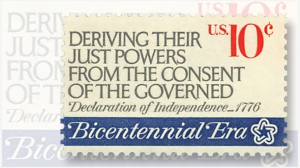 and new reasons for wishing an eternal separation.” (Time Inc., 1975, 1776 issue: Educational Edition, p. 7). 10C Deriving their Just Powers from the Consent of the governed, Declaration of Independence 1776 Bicentennial Era
and new reasons for wishing an eternal separation.” (Time Inc., 1975, 1776 issue: Educational Edition, p. 7). 10C Deriving their Just Powers from the Consent of the governed, Declaration of Independence 1776 Bicentennial Era
In one way, it could almost seem an accident of politics that the young Jefferson came to write the Declaration. According to John Adams, Jefferson urged the task on Adams, the brilliant, “truculent” Boston lawyer, who had proved himself the ablest debater of the independence cause. However Adams demurred on the grounds that he was personally “obnoxious” to many members of Congress, and that in any case Jefferson was the superior writer. Later, Adams explained that Jefferson had this “peculiar felicity of expression.”
Forty years later, Jefferson’s political enemies attempted to defame him by alleging that he did not even write the Declaration of Independence. The former Secretary of State, Vice President, and President who had arranged the Louisiana Purchase, refuted these charges with a rather detailed description of his circumstances in writing the Declaration. Jefferson simply stated that he intended it to be “an expression of the American mind.”
Historians have alleged that he merely copied the philosophies of others, such as Aristotle, or John Locke; but, they have agreed that the draft “combines solemnly elevated thought with artful political stratagem.” However, instead of copying others, Jefferson told us, “I turned to neither book nor pamphlet while writing it.  Why discredit the man? Perhaps to discredit the work? The Declaration of Independence has been analyzed thousands of times. 1993 Thomas Jefferson USA 29 , Great Americans Series, by Christopher Calle. Jefferson’s choice of wording has perplexed scholars. For instance the familiar sequence “life, liberty and the pursuit of happiness,” expected, according to some, to have been worded differently (i.e. life, liberty and property), and they were surprised that Jefferson had not given any reason for ma king the statements that he did make! In fact, the middle portion of the Declaration lists 27 charges against King George III. These charges are considered, in the Time article, as polemical and exaggerated. “Its intent, however, is not a strict and balanced accuracy but a maximum political effect to justify the conclusion” of the document. (Time, p. 13). By understanding chiasm we can see that the Declaration is exactly a “strict and balanced” statement.
Why discredit the man? Perhaps to discredit the work? The Declaration of Independence has been analyzed thousands of times. 1993 Thomas Jefferson USA 29 , Great Americans Series, by Christopher Calle. Jefferson’s choice of wording has perplexed scholars. For instance the familiar sequence “life, liberty and the pursuit of happiness,” expected, according to some, to have been worded differently (i.e. life, liberty and property), and they were surprised that Jefferson had not given any reason for ma king the statements that he did make! In fact, the middle portion of the Declaration lists 27 charges against King George III. These charges are considered, in the Time article, as polemical and exaggerated. “Its intent, however, is not a strict and balanced accuracy but a maximum political effect to justify the conclusion” of the document. (Time, p. 13). By understanding chiasm we can see that the Declaration is exactly a “strict and balanced” statement.
Furthermore, we can understand why Jefferson did not copy the Declaration from any other work, as there were none which would serve the purpose of the Almighty. “Because the world is touchy and resentful of what it does not understand – ‘dogs bark at strangers,’ says the immortal Heracleitus – the keeping of the record is much concerned with hiding, withholding, dissembling, rationing, and disguising.”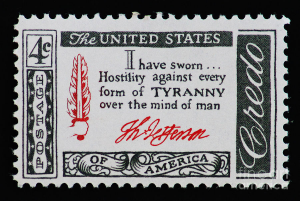 (Hugh Nibley, The Ensign, March 1976, p. 65) 1961 The United States of America Postage 4c Creo I have sworn Hostility against every form of Tyranny over the mind of man. ThJEFFERSON
(Hugh Nibley, The Ensign, March 1976, p. 65) 1961 The United States of America Postage 4c Creo I have sworn Hostility against every form of Tyranny over the mind of man. ThJEFFERSON
The entire Declaration of Independence is organized as an introverted parallelism (chiasm), around a major key which is. as follows:
Key #6 – Declaration of Independence a Major Key
A Declaration (verses 2 and 8) purposes for mankind.
B [Divine source] God, (verses 6 and 7) and Creator (verse II) the divine source of rights and mankind’s creation.
C Right (verses 10-24) A statement of rights, how they are secured, and protected.
D Patience with King (verses 21-33) before severing political ties, the colonies suffered injuries.
E Neglected Laws (verses 35-42) and suspended laws.
F Legislatures (verses 43-55) were dissolved for opposing the King and representing the people.
G Obstructing new Lands in colonies (verses 56-59) closed the frontier in America and prevented further settlements.
H Judges (verses 60-63) hindered and corrupted by influence.
I Taxes (verses 64-65) fed foreign officers who “eat out the [colonists’] ubstance.”
J Armies (verses 66-69) still remain ten years after the French and Indian war.
K Constitution (verses 70-72) attacked
J’ Armed Troops (verses 73-76)are quartered in the colonies.
I’ Taxes (verses 77-78) are imposed while cutting foreign trade.
H’ Jury (verses 79-81)protects against corruption of the judges.
G’ Enlarged boundaries in Quebec (verses 82-85) into the Ohio river valley, to encourage growth in the North.
F’ Legislative (verses 86-89) charters are important.
E’ Abdication of Government (verses 90-105) by plundering, war, and invasion.
D’ Humble petitions denied (verses 106-121)lowers the King to a Prince by his actions.
C’ Rights (verses 126-133) to be free and do all of the acts that a free and independent country can do.
B’ [Divine Source], Supreme Judge, and Divine Protection (verses 123-124) The last appeal for help is made to God, who is also the new protector.
A’ Declaration (verses 123 and 126) The Colonies solemnly “publish and declare” their independence.
This is the major key for the Declaration of Independence and an examination will show you how the chiasm organization focuses on the Constitution.
In key A we can observe the verses 2 to 8. The paragraph begins
Key #7 Declaration beginning
AA “the Unanimous DECLARATION of the thirteen
BB United States of America.
CC When in the course of HUMAN events,
CC’ it becomes necessary for one PEOPLE
DD to DISSOLVE the political bands which
DD’ have CONNECTed them with another, and
DD’ to ASSUME among the POWERs of the earth,
EE the SEPARATE and equal station to which the
FF Laws of
GG NATURE and of
GG’ NATURE’s
FF’ God entitle them,
CC’’ a decent respect to the opinions of MANkind requires
AA’ that they should DECLARE the causes
EE’ which impel them to the SEPARATION.”
We can see that this paragraph is blocked off with the initial words, “Declaration” in the beginning of the paragraph and the word “declare” repeating the statement at the end of the paragraph.
This is balanced in the last paragraph, Key A’ verses 122-135, by this quotation:
Key #8 Declaration and Divine
BB “We, Therefore, the Representatives of the United States of America, in General Congress, Assembled,
FF’’ appealing to the SUPREME Judge of the world for the rectitude of our intentions,
CC do, in the Name, and by Authority of the good People
HH of these COLONIES,
AA’’ solemnly publish and DECLARE, That these
HH United COLONIES are,
II and of RIGHT ought to be
JJ Free and INDEPENDENT STATEs; that they are
DD ABSOLVED from all Allegiance to the
KK BRITish Crown,
DD and that all political CONNECTion between them and the
JJ State of Great
KK BRITain,
DD is and ought to be totally DISSOLVED; and that as
JJ Free and INDEPENDENT STATEs
DD they have full POWER to levy War, conclude Peace, contract Alliances, establish Commerce, and to do all other Acts and Things which
JJ INDEPENDENT STATEs
II’ may of RIGHT do.
AA And for the support of this DECLARATION,
FF with a firm reliance on the protection of DIVINE Providence, we mutually pledge to each
FF other OUR Lives,OUR Fortunes and OUR SACRED Honor.”
We can see that the balance of the words “declare” and “Declaration” are reversed in the chiasm order, ABB’A’, and that they set apart the statement of the last paragraph concerning the establishment of the independent states.
Key 8 notes the references to the “DIVINE providence,” “SUPREME Judge,” and “GOD,” which are three of the four references to deity in the Declaration.
The other reference is Key #9, the endowment
“We hold
these truths to be self evident, that all men are
CREATED equal, that they are
endowed by their
CREATOR with certain unalienable Rights, that among
these are Life, Liberty and the Pursuit of Happiness.”
Key #9 within #6C, the statement of rights, is balanced within Key #8 by the phrase “of RIGHT ought to be” and “LIBERTY” with “Free” and discussion of the “full Power to levy War, conclude Peace, contract Alliances, establish Commerce, and to do all other Acts and Things which Independent States may of RIGHT do.”
Taking two other examples of this Key #6, let us go to key G, verse 56, which states –
Key #10 – Lands and migrations
RR “He has endeavoured to prevent the population of
SS these States;
TT for that purpose OBSTRUCTING
UU the LAWS for Naturalization of Foreigners;
TT refusing to pass others to encourage their migrations
hither, and
TT raising the conditions of new Appropriations of Lands.”
We can observe that the charge was one of stifling the growth and migration in the American colonies, especially into the Ohio valley.
This is contrasted at line G’, verses 82-84, which states:
Key #11-
TT “For ABOLISHING the free System of English
UU LAWS in a neighbouring Province,
TT establishing there in an Arbitrary government, and
TT enlarging its Boundaries so as to render it at once an
example and
RR fit instrument for
TT introducing the same absolute rule into
SS these Colonies:”
Given the efforts to obstruct new lands in middle America, what could show an evil contrast than to enlarge the boundaries in Quebec by giving it the Ohio valley? This chiasm fulfills our understanding and expectation with the repetition, contrast, and change in tone.
Another example is key #6H, verses 60-65, which states:
Key #12 – Justice
MM “He has obstructed the Administration of
NN JUSTICE, by
OO REFUSING his Assent to Laws for establishing
NN JUDICIARY powers. He has made
NN Judges dependent on his Will alone, for the tenure of their offices, and the amount and payment of their salaries.”
This is balanced by line Key #6H’, verses 79-81:
Key #13 – Jury
OO “For DEPRIVING us in many cases, of the benefits of
PP TRIAL by
NN JURY: For transporting us beyond Seas to be
PP TRIED for pretended offenses:”
The Judges are deprived of salaries, while the people are deprived of Juries. A paralleled concept.
Key #14 – Tax
In Key #6H, verses 64-65, we read:
PP “He has erected a multitude of New
QQ Offices, and sent hither
PP swarms of
QQ Officers to
RR harass our people, and
RR EAT out their substance.”
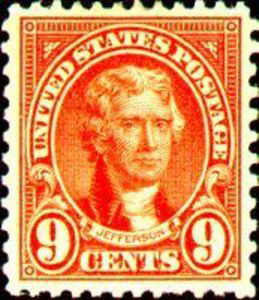 9 Cents Jefferson United States Postage 1927
9 Cents Jefferson United States Postage 1927
What does the phrase “eat out their substance” refer to? Let us look for the reference which will balance the second half of the declaration. Could this be the appropriate reference? Line H’, at verse 78, reads:
Key #15 – Tax
RR For imposing TAXES on us
SS without our Consent”
This is tax reference balances the phrase “eat out their substance.”
At key #6I, verses 66-69 , we read
Key #16 – Army
PP “He has kept AMONG US, in times of peace,
TT Standing ARMIES
SS without the Consent of our
UU legislatures. He has affected to render the
TT MILITARY independent of and superior to the
UU Civil power.”
This is balanced at verses 73-76. The reference to armies, is repeated by one to troops
Key #17 – Among US
TT “For quartering large bodies of ARMED troops
PP AMONG US:”
The prior reference of the subjection of the civil power to the military, is balanced by the phrase:
Key #18 – Trial
“For protecting them, by a mock
PP Trial, from punishment for any Murders which they should commit on the Inhabitants of these States.”
(verses 74-76).
What is the focus of major key #6 in the Declaration? Our divinely Inspired Constitution. Key #6K, verses 70-72, states:
Key #19 – Constitution
“He has combined with others to subject us to
a jurisdiction foreign to our CONSTITUTION, and unacknowledged by our
laws; giving his Assent to their acts of pretended Legislation:”
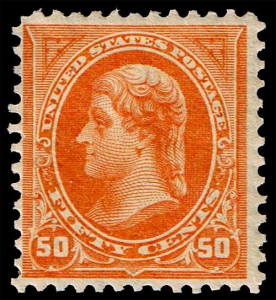 1894 Thomas Jefferson 50 Cents United States PostageBy the use of parallelism we can discover rich and deep meanings of the Declaration of Independence. At that time there were many colonial charters, which served like constitutions, but Constitution was in the singular in the Declaration. There was also the Articles of Confederation. There was no pan colonial . constitution. Not then anyway. Did the Declaration prophesy the Constitution, by which both now lies in the National Archives? Did the Lord intend to tell, in advance, the Constitution which would be adopted more than a decade later? This is nothing new.
1894 Thomas Jefferson 50 Cents United States PostageBy the use of parallelism we can discover rich and deep meanings of the Declaration of Independence. At that time there were many colonial charters, which served like constitutions, but Constitution was in the singular in the Declaration. There was also the Articles of Confederation. There was no pan colonial . constitution. Not then anyway. Did the Declaration prophesy the Constitution, by which both now lies in the National Archives? Did the Lord intend to tell, in advance, the Constitution which would be adopted more than a decade later? This is nothing new.
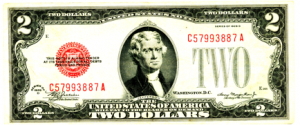 1928 Jefferson Two Dollars United States Note.
1928 Jefferson Two Dollars United States Note.
“According to the laws and constitution of the people, which I have suffered to be established, and should be maintained for the rights and protection of all flesh, according to just and holy principles;” (Doctrine and Covenants Section 101 at verse 77). And again “And for this purpose have I established the Constitution of this land, by the hands of wise men whom I raised up unto this very purpose, and redeemed the land by the shedding of blood.” (Verse 80). And at the dedication of the first temple in almost two millennia, at Kirtland, this prayer, “Have mercy, O Lord, upon all the nations of the earth; have mercy upon the rulers of our land; may those principles, which were so honorably and nobly defended, namely, the Constitution of our land, by our fathers, be established forever.” (D&C section 109 at verse 54).
In addition to carrying their own evidence of authenticity, or truthfulness, the Lord’s actions are revealed in advance. When He is planning something, He tells us. Why would not this also include the Constitution? Isaiah wrote “Before it came to pass I showed them to thee, lest thou shouldst say mine idol hath done them.” This is in the Old Testament, and quoted by Nephi in the Book of Mormon, Another Testament of Jesus Christ. We got the advice twice. The Lord does not want us to think things are by chance. They are not, and He has told us. President Benson twice spoke on the need to show God’s hand in our nation’s history, first at BYU in March of 1976, and again ten years later, in August, at the Sons of Utah Pioneers Convention banquet (See Church News August 31. 1986). In the Doctrine and Covenants Section 59, the Prophet Joseph wrote, that “in nothing else doth man offend God than not to acknowledge him in all things.
“By far the most subtle use of chiasmus in any work is its role in creating the structural design behind longer passages and entire books,” wrote Welch. He suggests how the first book of Nephi, in the Book of Mormon revolved around the vision of the Spirit of the Lord in chapter 11. His key for this book by chapter was as follows:
Key #20 – The Book of Mormon – The First Book of Nephi (Welch)
A Lehi’s dream leads him to prophesy warnings to Jews (chapter I)
B The departure from Jerusalem (2)
C Nephi accomplishes a great feat in obtaining the brass plates of 1 Nephi 3:7; the brothers are confounded 3-5
D lshmael joins the group with his daughters (7)
E The tree of life (8)
F Lehi prophesies about the Old World and the coming of the Lord (10)
G Nephi and the Spirit of the Lord (II)
F’ Nephi prophesies about the New World and the coming of the Lamb (12-14)
E’ The tree of life interpreted (15)
D’ The sons of Lehi marry the daughters of Ishmael and Ishmael dies (16)
C’ Nephi accomplishes a great feat by building a ship of I Nephi 17:3; the brothers are confounded (17)
B’ The departure from the Old World (18)
A’ Nephi warns the Jews and quotes the prophecies of Isaiah (19-22) (The New Era, February 1972, p. 9).
It is not a simple coincidence that the Book of Mormon and the Declaration of Independence are undeniably parallel in style. President Ezra Taft Benson warned: “The country is reaping the effects of this agnostic influence, there are inestimable consequences. Why is it that references to God’s influence in the nation’s founding are no longer mentioned?” (Church News, April 3, 1976, P. 7).
A chiasm in the Declaration of Independence could be an effective token of God’s influence. Also, the focus on the Constitution? Washington said “No people can be bound to acknowledge and adore the invisible hand, which conducts the affairs of men, more than the people of the United States. Every step, by which they have advanced to the character of an independent nation, seems to have been distinguished by some token of providential agency. . .” (First Inaugural Address, Church News, December 27, 1975, p. 4).
The chiasm in the Declaration of Independence also supports the Constitution. Neal R. Maxwell stated that he foresaw the day when the Church would fulfill the promise of President John Taylor, who said the days would come when the Church would be as far ahead of the world in things educational as it is in things spiritual. (Church News, April 24, 1976, p. 8).
Chiasmus, in the Declaration of Independence, so similar to this form of scripture in the Bible, and the Book of Mormon Another Testament of Jesus Christ, remains obscured from the eyes of the world. Chiasmus offers us another touch stone to divine inspiration. Welch wrote, “Scholars are saying things today like, ‘where there is chiasmus, there is the influence of a Hebraic hand’.” The Book of Mormon is richly chiastic, as it admits it is influenced in the style from Hebrew.
What else does the Latter Day Saint know about the Declaration of Independence? President Wilford Woodruff stated: “I am going to bear my testimony to this assembly, if I never do it again in my life, that those men who laid the foundation of this American government and signed the Declaration of Independence were the best spirits the God of Heaven could find on the face of the earth. They were choice spirits, not wicked men. Another thing I am going to say here, because I have a right to say it. Everyone of those men that signed the Declaration of Independence, with General Washington, called upon me, as an Apostle of the Lord Jesus Christ, in the Temple at St. George, two consecutive nights, and demanded at my hands that I should go forth and attend to the ordinances of the House of God for them. . . Brother McAllister baptized me for all those men, and then I told those brethren that it was their duty to go into the Temple and labor until they had got endowments for all of them. They did it. Would those spirits have called upon me, as Elder in Israel, to perform the work if they had not been noble spirits before God? They would not. I bear this testimony, because it is true. The Spirit of God bore record to myself and the brethren while we were laboring in that way.” [General Conference Report, April 10, 1898, quoted in the Great Prologue by Mark E. Petersen, 1975, p. 77] Now recall the statement of John Adams, about “a peculiar felicity of expression.”
Ezra Taft Benson has added his testimony to that of President Woodruff. He related, “President Spencer W. Kimball …assigned me to go into the vault of the St. George Temple and check the early records. As I did so, I realized the fulfillment of a dream I had had ever since learning of the visit of the Founding Fathers to the St. George Temple. I saw with my own eyes the record of the work which was done for the Founding Fathers of this great nation…These noble spirits came [to the Temple] with divine permission – evidence that this work of salvation goes forward on both sides of the veil.” (Ezra Taft Benson, “The Constitution–a Glorious Standard,” Ensign, September 1987, p. 8.)”I testify that America is a choice land. God raised up the founding fathers of the United States of America and established the inspired Constitution. This was the required prologue for the restoration of the gospel.” (Ezra Taft Benson, “I Testify,” Conference Report, October 1988, p. 87.)
Of what significance is this to the Latter Day Saint? President Romney stated no person can be justified in rejecting theteachings revealed by the Lord on the basis that he does not know that they are true, because everything the Lord says has within itself the evidence of its own authenticity. The Saints should not be mislead by the false statements of an ignorant world. Nor should we allow these founding Fathers to be defamed, especially since they are now all members of the Church. We know they accepted the gospel as they had permission, probably from Jesus Christ personally, to appear to President Woodruff. 1620-1920 Pilgrim Tercentenary The Mayflower 1 cent. Green.
The Saints should not be mislead by the false statements of an ignorant world. Nor should we allow these founding Fathers to be defamed, especially since they are now all members of the Church. We know they accepted the gospel as they had permission, probably from Jesus Christ personally, to appear to President Woodruff. 1620-1920 Pilgrim Tercentenary The Mayflower 1 cent. Green.
President Benson stated: “For years we have heard of the role the Elders could play in saving the Constitution from total destruction. But how can the Elders be expected to save it if they have not studied it and are not sure that it is being destroyed or what is destroying it?” (An Enemy Hath Done This by Ezra Taft Benson, 1969, p. 313, in reference to President Brigham Young, Journal of Discourses, 7:15). ‘Our liberties are safe until the memories and experiences of the past are blotted out and the Mayflower with its band of pilgrims forgotten; until our public-school system has fallen into decay and the Nation into ignorance.” (Benson, p. 233, quoting Woodrow Wilson).
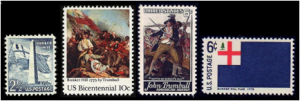 Should we not study the Declaration and Constitution if we expect to protect our heritage and liberty? Chiasm supports the Declaration, and the Declaration prophesies about the Constitution. And does not this also fulfill prophesy given in the word of wisdom that “all Saints who remember to keep and do these things, . . . shall find wisdom and great treasures of knowledge, even hidden treasures?” (Doctrine and Covenants Section 89: 18-19). We also have prophesy given as early as Paul, when he stated that “This know also, that in the last days perilous times shall come. For men shall be. . . unthankful, unholy. . Having a form of godliness, but denying the power thereof: from such turn away. . . Ever learning, and never able to come to the knowledge of
Should we not study the Declaration and Constitution if we expect to protect our heritage and liberty? Chiasm supports the Declaration, and the Declaration prophesies about the Constitution. And does not this also fulfill prophesy given in the word of wisdom that “all Saints who remember to keep and do these things, . . . shall find wisdom and great treasures of knowledge, even hidden treasures?” (Doctrine and Covenants Section 89: 18-19). We also have prophesy given as early as Paul, when he stated that “This know also, that in the last days perilous times shall come. For men shall be. . . unthankful, unholy. . Having a form of godliness, but denying the power thereof: from such turn away. . . Ever learning, and never able to come to the knowledge of  the truth.” (2 Timothy, 3:1-2, 5 and 7).
the truth.” (2 Timothy, 3:1-2, 5 and 7).
1620-1920 Pilgrim Tercentenary Landing of the Pilgrims 2 cents. Red.
The Declaration of Independence has a form of godliness. Yet some deny the power of God in its formation. Nor have they observed the poetry even after many readings. For those who would discredit our Forefathers, are they not “ever learning, and never able to come to the knowledge of the truth?” “All scripture is given by inspiration of God, and is profitable for doctrine, for reproof, for correction, for instruction in righteousness; that the man of God may be perfect, thoroughly furnished unto all good works.” (2 Timothy 3:16-17).
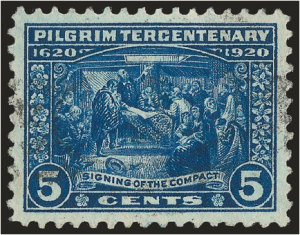 1620-1920 Pilgrim Tercentenary Signing of the Compact 5 cents. Blue.
1620-1920 Pilgrim Tercentenary Signing of the Compact 5 cents. Blue.
The engrossed (original with signatures) document is now enshrined in the National Archives Building at Washington, D.C. next to the Constitution and the Bill of Rights. May it continue to be preserved for another 200 years, in the name of Jesus Christ, Amen.
Declaration Article – Choate
 1620 The Landing of the Pilgrims U.S. Postage 6 cents 1970, 350th anniversary.
1620 The Landing of the Pilgrims U.S. Postage 6 cents 1970, 350th anniversary.
FOOTNOTES
(1) Church News, April 10, 1976, p. 20.
(2)The Federalist Papers, #37. Quoted by Ezra Taft Benson in speech, March 28, 1976, p. 10
(3) Church News, August 31,1986, p. 3.
(4) Ezra Taft Benson, text of address to BYU fireside, March 28, 1976, p. 7
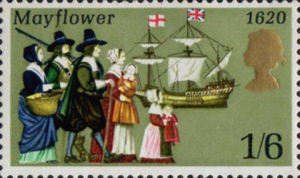 .1620 Mayflower 1 shilling 6 pence. 1970. United Kingdom.
.1620 Mayflower 1 shilling 6 pence. 1970. United Kingdom.
(5) Edward Dumbauld, The Declaration of Independence and What It Means Today. Norman, Oklahoma: The University of Oklahoma Press 1950, p. 11.
(6) For details surrounding the Declaration refer to American History at a Glance, Marshall Smelser and Joan R. Gunderson; New York: Barnes & Noble, 1978. Also, Signers of the Declaration, edited by Robert G. Ferris; Washington: National Park Service, 1973.
(7) John W. Welch, “Chiasmus in the Book of Mormon.” The New Era, February 1972, p. 6
(8) Ibid., p. 6
(9) Ibid., p. 8.
(10) Ibid., p. 10.
(11) The Jewish Encyclopedia. New York: Funk & Wagnall’s, 1925. Vol. IX, p. 522.
(12) Encyclopedia Judaica. Jerusalem: The Macmillan Company, Vol. II, p. 536; vol. XIII, p. 677.
(13) Insights, newsletter of the Foundation for Ancient Research and Mormon Studies, Provo, Utah. Winter 1988, p. 2.
(14) Welch, p.. 10-11.
(15) Dumbauld, p. 137.
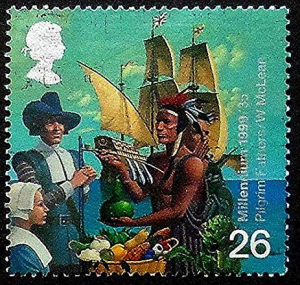 26 pence Millenium 1999 Pilgrim Fathers / McLean. UK
26 pence Millenium 1999 Pilgrim Fathers / McLean. UK
(16) Ibid., p. 116.
FOOTNOTES
John Choate and Mark Choate
“Inspired from on High: the Declaration of Independence,” Part 2
1) Edward Dumbauld, The Declaration of Independence and What It Means Today, Norman, Oklahoma: University of Oklahoma Press, 1950 18.
2) Webster’s New Collegiate Dictionary, Springfield, Mass.: G.C Merriam Co., 1959, p. 581.
3) Dumbauld, p. 137.
4) Webster’s Dictionary, p. 151
5) The Writings of Thomas Jefferson, ed. Andrew Lipscomb, Washington, D.C.: The Thomas Jefferson Memorial Association, 1903, 1: 17-18.
6) Dumas Malone, Jefferson the Virginian, Boston: Little, Brown and Company, 1948, pp. 219-220.
7) As quoted by Timothy Pickering, Colonel Pickering’s Observations Introductory to Reading the Declaration of Independence, Salem, Mass.: Warwick Palfray, 1823, p. 8.
8) Diary and Autobiography of John Adams, ed. L.H. Butterfield, Cambridge, Mass.: Harvard University Press, 1961, 3: 336-337.
9) Writings of Jefferson, 15: 461.
10) Ibid., 1:26.
11) Ibid., 15: 462.12) Discourses of Brigham Young, sel. John A. Widstoe, Salt Lake City: Deseret Book Co., 1954, p. 359.
13) As quoted in Temples of the Most High, sel. N.B. Lundwall, Salt Lake City: Bookcraft, 1968, p. 82.
14) Ezra Taft Benson, “The Constitution–a Glorious Standard,” Ensign, September 1987, p. 8.
15) Ezra Taft Benson, “I Testify,” Conference Report, October 1988, p. 87.
16) First inaugural address, printed in Speeches of the American Presidents, ed. Janet Podell and Steven Anzovin, New York: The H.W.Wilson Co., 1988, p.3.
17) Catherine Drinker Bowen, Miracle at Philadelphia, Boston:Little, Brown and Company, 1966, pp. 125-126.
18) The Works of John Adams, with a Life of the Author, sel.Charles Francis Adams, Boston: Little, Brown and Company, 1956, 1:66.
19) The Collected Works of Abraham Lincoln, ed. Roy P. Basler, New Brunswick, N.J.: Rutgers University Press, 1953, 4:240.
20) Ibid., 1:109.
21) Ibid., 3:95.
22) Speeches of the American Presidents, p. 80.
23) Ibid., p. 84.
24) “The Constitution–a Glorious Standard,” pp. 6-8.
25) Merrill Peterson, Thomas Jefferson and the New Nation, New York: Oxford University Press, 1970, pp. 140-141.
26) First amendment to U.S. Constitution, printed in Documents Illustrative of the Formation of the Union of the American States,Washington D.C.: Government Printing Office, 1927, p. 1066.
27) A Bill for Establishing Religious Freedom, printed in The Portable Thomas Jefferson, ed. Merrill Peterson, New York: Viking Press, 1975, p. 252.
Disclaimer: The author of each article published on this web site owns his or her own words. The opinions, beliefs and viewpoints expressed by the various authors and forum participants on this site do not necessarily reflect the opinions, beliefs and viewpoints of Utah Standard News or official policies of the USN and may actually reflect positions that USN actively opposes. No claim in public domain or fair use. © John Choate with research by Mark Choatem 1976,1988,2003 Copyright, Proprietary
Utah Standard News depends on the support of readers like you.
Good Journalism requires time, expertise, passion and money. We know you appreciate the coverage here. Please help us to continue as an alternative news website by becoming a subscriber or making a donation. To learn more about our subscription options or make a donation, click here.
To Advertise on UtahStandardNews.com, please contact us at: ed@utahstandardnews.com.


Comments - No Responses to “Part Twenty Five Why study social media, chiasm, the Declaration of Independence, and Constitution, and inspiration?”
Sure is empty down here...